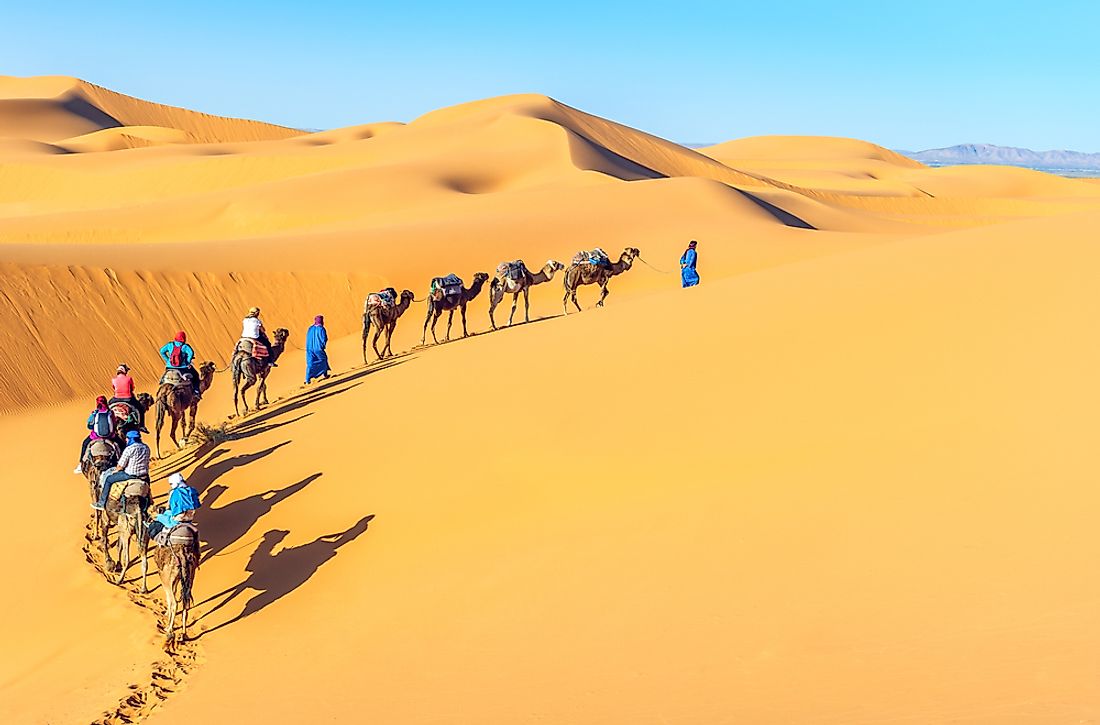The Six Ecoregions Of The Sahara Desert

The Sahara Desert is the largest low-altitude hot desert and the world’s third-largest desert. It covers a total area of approximately 3.6 million square miles, which is almost the size as the US. The Sahara Desert covers much of the northern part of Africa stretching from the Red Sea in the eastern side to the Atlantic Ocean on the western side. It is bounded to the south by the Sahel which is a semi-arid tropical savanna. Sahara is an Arabic plural word for ‘desert.’ The Sahara desert is divided into several ecological regions, outlined below.
6. Tibesti-Jebel Uweinat Montane Xeric Woodlands
Tibesti-Jebel Uweinat montane xeric woodlands ecoregion cover the eastern parts of the Sahara. The ecoregion occupies two different highland regions and covers an area of about 31,700 square miles. The ecoregion experiences arid and subtropical climate but in the winter temperatures can reach 0 at high altitude. The region experiences irregular rainfall but are not as arid as other parts of the Sahara. Tibesti-Jebel Uweinat montane xeric woodlands support a large population of desert mammals including Addax, Dorcas Gazelle, and Cheetah. The ecoregion is fairly stable although hunting is a major threat to the large mammals.
5. West Saharan montane xeric woodlands
West Saharan montane xeric woodlands ecoregion covers a number of highland areas in the Sahara Desert. The ecoregion covers an area of about 99,700 square miles. The largest part of the ecoregion is comprised of volcanic lava. West Saharan montane xeric woodlands are cold and dry during winter and hot and dry during summer. Precipitation varies but averages below 100 mm annually with higher elevation experiencing a high amount of rainfall. Maximum temperatures within the ecoregion may reach 30 degrees C at lower elevations and 15 degrees C at the highest elevation. The vegetation varies according to the elevation and landscape features. The diverse vegetation hosts several animals including Waterbirds, white stock, cheater, and Barbary sheep. Much of the ecoregion is still intact and protected by its inaccessible location.
4. South Saharan steppe and woodlands
South Saharan steppe and woodlands ecoregion extend across the northern Africa and cover part of Western Sahara. The ecoregion experiences extreme climate with water being a serious constraint. The climate is hot and dry during the summer season and cooler in winter. The ecoregion is home to endemic species of both flora and fauna making it distinct from other regions within Sahara. Some of the common wildlife in the area includes four-toed jerboa, North African gerbil, and the Sand gerbil. The habitat of the South Saharan steppe and woodlands ecoregion is still largely intact but it is poorly protected exposing it to animal grazing. The threats are concentrated in areas that receive a high amount of rainfall.
3. Sahara Desert ecoregion
0The Sahara Desert ecoregion include the arid center of the desert covering the northern portion of Africa. The ecoregion covers an area of about 1.7 million square miles of the hot Sahara Desert. The ecoregion is characterized by a large track of sand dunes, salt flats, and sandy plains. It is among the driest and hottest places of the world with temperatures reaching over 30 degrees C. Daily temperature variations may be extreme (37 degrees C to -0.5 degrees C). Rainfall is scarce throughout the year with the ecoregion receiving less than 100 mm annually. The ecoregion is largely intact with the most threats occurring in areas with water.
2. North Saharan steppe and woodlands
North Saharan steppe and woodlands ecoregion form the northern tip of the Sahara. It covers an area of approximately 646,000 square miles and is characterized by hot and dry climate during summer and a cooler and rainy winter. The rainfall averages 100 mm in the north and 50 mm in the south annually. Temperatures may rise to 40 degrees C during summer and evaporation is much higher than precipitation. North Saharan steppe and woodlands ecoregion have varying habitat including sandy, rocky, wadis, and depression. The ecoregion is inhabited by snakes, lizards, mountain gazelle, and several species of birds.
1. Atlantic coastal desert
The Atlantic coastal desert ecoregion covers the western part of the Sahara Desert of North Africa. It covers a narrow line along the Atlantic Coast frequented by fog and haze. The ecoregion covers an area of approximately 15,400 square miles and borders the Atlantic Ocean with the ocean current giving it a higher atmospheric stability. The atmospheric stability in the desert reduces the amount of rainfall leading to an extremely dry climate with an annual precipitation of about 30mm. temperature ranges between 27 degrees C and 13 degrees C with an average daily temperature of 200C. The biodiversity is fairly endemic but has no endemic fauna. Plants consist of variety lichens and drought-resistant shrubs.











